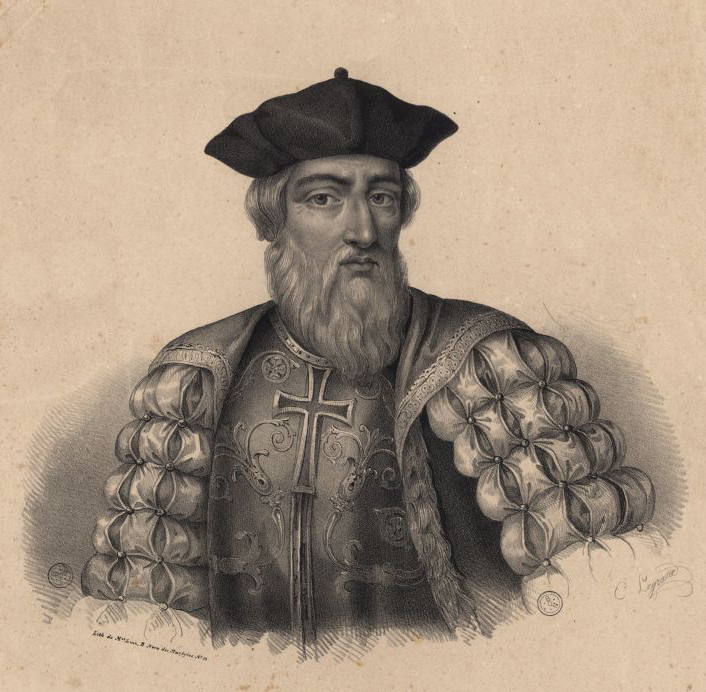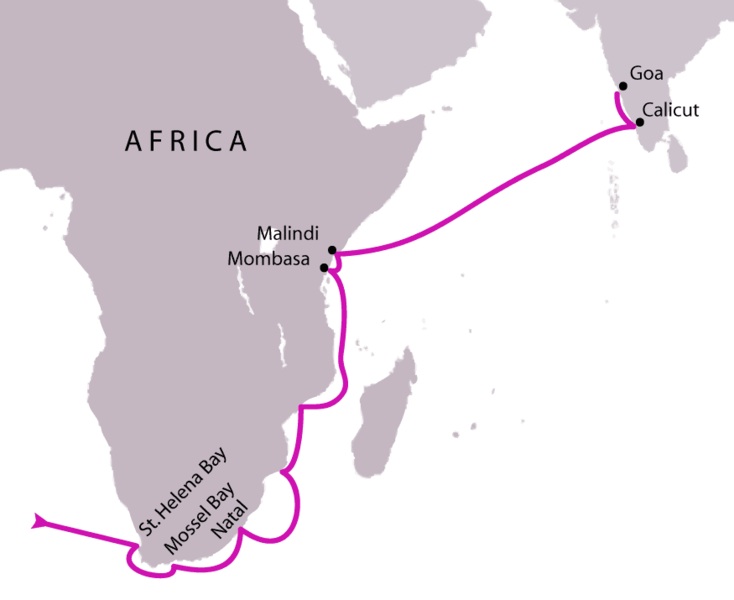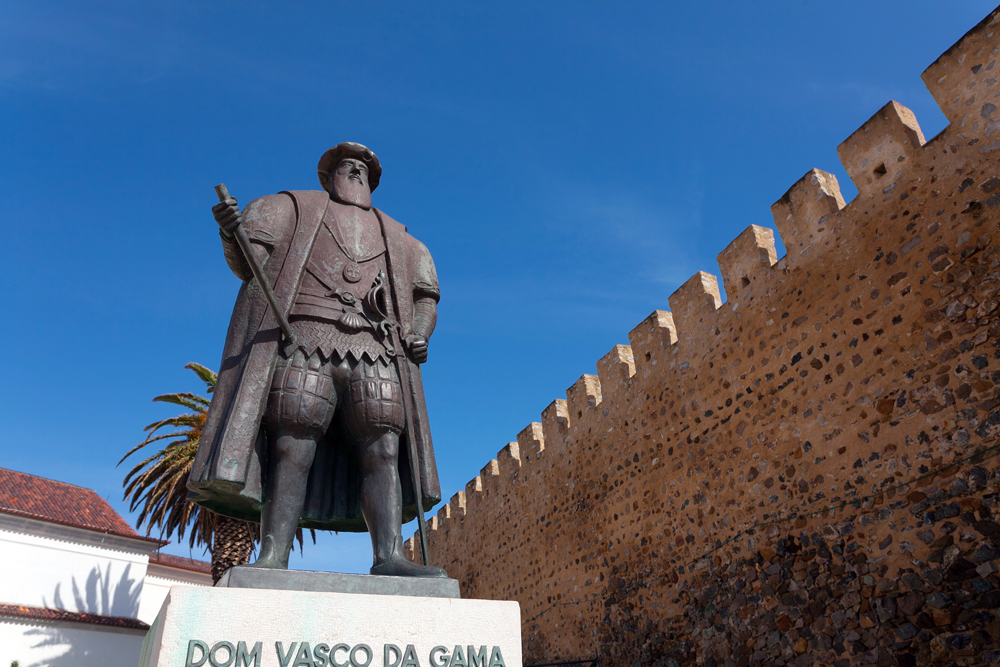Vasco da Gama: Facts & Biography

Vasco da Gama was a highly successful Portuguese sailor and explorer during the Age of Exploration. He was the first person to sail directly from Europe to India, around the Cape of Good Hope. His discovery was monumental in the history of navigation as well as instrumental in establishing Portugal as a major colonial empire.
A route to India
Da Gama was born in 1460 to a family of nobles in Sines, Portugal. His father, Estevao, was also an explorer. Da Gama learned to navigate in the navy, which he joined as soon as he was old enough. In 1497, da Gama was appointed to command a ship with the goal of discovering a sailing route to India.
Several decades earlier, Henry the Navigator had patronized several successful voyages in North and West Africa. These voyages were Portugal’s first steps at becoming a major maritime and colonial power. In 1487, Bartolomeu Dias discovered that the Indian and Atlantic Oceans were connected. This interested Portuguese King Manuel. He wished to conquer Islam and establish himself as the King of Jerusalem, in addition to making money off the spice trade.

De Gama captained four vessels when he set out on July 8, 1497. Da Gama himself rode in the 200-ton St. Gabriel and his younger brother Paulo led the St. Rafael. Da Gama sailed south, taking advantage of the prevailing winds off the western coast of Africa, and swung out into the Atlantic before veering back in an arc to meet the South African coast. He then rounded the Cape of Good Hope and ventured into the Indian Ocean.
By the time they reached Indian Ocean waters, most of his crew was infected with scurvy. Da Gama made landfall in Mozambique to rest and resupply. There, they had skirmishes with the sultan who did not believe the Europeans’ gifts were sufficient. They then landed in Mombasa and Malindi, where an Arab guide agreed to assist da Gama; the guide may have been famous Arab navigator Ahmed Ibn Magid.
Da Gama’s fleet sailed for 23 days before landing at Calicut, India, (modern-day Kozhikode) on May 20, 1498. The Europeans assumed the locals were Christians, though they were actually Hindus. Despite this misunderstanding, the ruler of Calicut agreed to trade with da Gama and he acquired a large supply of valuable spices. The Muslims who already traded at Calicut, however, were less inviting of da Gama’s competition and forced da Gama to barter many of his spices in order to acquire sufficient supplies for the trip home.

Return to Portugal
In August, after three months in India, da Gama’s fleet left Calicut — despite advice that monsoon season was approaching. The ships encountered terrible storms during their journey. The passage across the Indian Ocean — which had previously taken little more than three weeks — took more than three months. So many men died of scurvy during the crossing that da Gama ordered the St. Rafael burned for lack of crew.
The ships split up off the western coast of Africa, returning to Lisbon at different times. Da Gama’s brother Paulo fell ill and da Gama took him to the Azores with hopes of healing him. Paulo died on the Azores and, after mourning on the island for some time, da Gama eventually returned to Portugal more than one month after the other ships had come back.
Ultimately, it took da Gama’s fleet more than a year to return to their homeland after leaving India. Though only 54 of the original 170-member crew returned to Portugal in 1499, da Gama received a hero’s welcome. He was made an admiral and married Catarina de Ataíde, a woman of a noble family. The spice trade was hugely important for Portugal and soon after da Gama’s return, King Manuel dispatched another expedition to India, led by Pedro Alvares Cabral. Cabral established a trading post in Calicut, but conflicts with the local Muslims resulted in battles and the deaths of 70 Portuguese.
Second voyage to India
In 1502, King Manuel once again sent da Gama to India to further secure Portugal’s dominance in the region. Da Gama left Lisbon with 20 armed ships under his command. During his journey, da Gama slaughtered hundreds of Muslims, attacking ships and firing cannons at trading posts up and down the east African coast. In one instance, he ordered the massacre of 380 people — including women and children — aboard a Muslim ship returning from Mecca.
His brutal practices continued once he reached Calicut. There, da Gama destroyed the trading post and killed 38 hostages. Once he had the Calicut ruler's surrender, da Gama went south to Cochin (known as Kochi today). There, he made an alliance with the local ruler, further securing Portugal’s position as a dominant spice trader.
Da Gama left Cochin in February 1503. During his return journey, he established Portuguese trading posts in what is now Mozambique. Portugal would later become the major colonial power in Mozambique.
As part of this second India voyage, da Gama's uncles —Vicente and Brás Sodré — were put in charge of a five-ship squadron with instructions to protect friendly trading states on India's west coast. They were also tasked with disrupting Arabic shipping along the route, according to David Mearns, of Blue Water Recoveries in the United Kingdom. Disobeying such orders, the uncles, and their squadron, instead set off for the Gulf of Aden, carrying out a campaign of piracy.
At one point, after killing everyone on five Arab ships, the Sodré brothers took shelter in a bay off the southern coast of Oman to repair their own ships. Not heeding the advice of local fishermen about impending strong winds, their ships ripped from their moorings. Vicente's ship sank in deep water, killing him and his crew. It is this ship, the nau Esmeralda, that scientists think they have discovered off the coast of Oman, they announced in March 2016. [See Photos of the Lost nau Esmeralda Ship]
Life in Portugal and final voyage
For 20 years, da Gama lived in Portgual with his wife, six sons and one daughter. He continued to advise King Manuel on matters regarding India and was made count of Vidigueira in 1519.
After King Manuel died, King John III asked da Gama to return to India once again. He was requested to help deal with the increasing corruption of the Portuguese officials there. In 1524, da Gama yet again set sail — this time with the title of Viceroy.
Da Gama fell ill soon after arriving in Cochin. He died from an unnamed illness on Dec. 24, 1524. He was initially buried in a Catholic church in Kochi, but his remains were eventually brought back to Portugal in 1538.
Sign up for the Live Science daily newsletter now
Get the world’s most fascinating discoveries delivered straight to your inbox.
Jessie Szalay is a contributing writer to FSR Magazine. Prior to writing for Live Science, she was an editor at Living Social. She holds an MFA in nonfiction writing from George Mason University and a bachelor's degree in sociology from Kenyon College.










